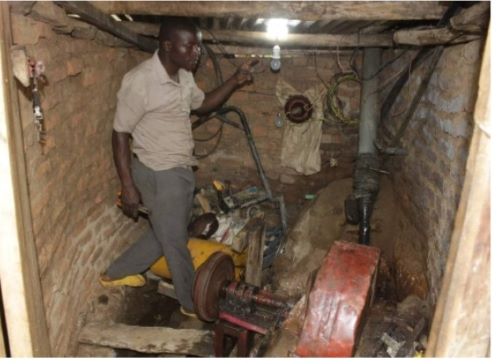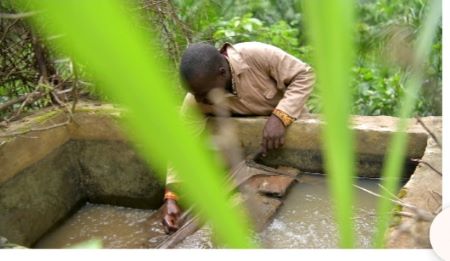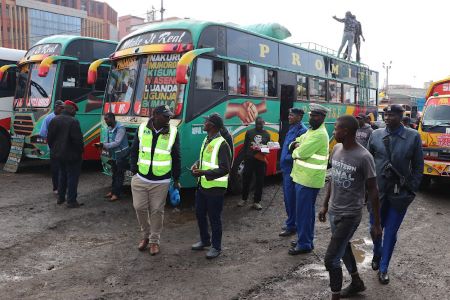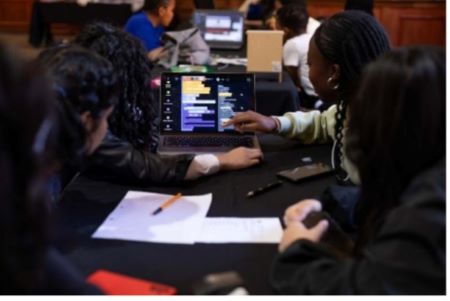Alexandre Ndayishimiye
While some communities in Burundi have problems accessing electricity, 20 -year old Emile Irakoze has found a solution in his native Kiyagayaga hill, Rusabagi zone, Burambi commune, Rumonge Province (Southern Burundi).

Emile Irakoze, the initiator
He has built an electric dam with 15 kilowatts (15 KW) capacity. Located on Nyamihire River, 80 kilometers from Bujumbura the country’s capital city, the dam powers homes of about 20 families. The engine of this dam is located in a small house measuring 2 meters by 2.5 meters built with fired bricks and covered with sheet metals.
“I receive a lot of households demands. They also need power “, the young initiator of the project who is self-taught said.
“At a young age, I was really handy boy. Each time I tried to repair my father’s radio my goal was to understand how it works. Especially how its integrated circuit works,” he explains.
By repeating the same exercise, he finally understood the operation of the integrated circuit of a radio. So, the idea of building an electric dam occurred to him. Before starting his current project, he first attempted to operate a mill using a dynamo and he succeeded.
With the dam now more than two years old, the initiator of the project is currently studying the modalities to be able to supply a large part of his native hill. “At the moment, the pipes I use are small: 60 calibers. I am doing my best to have others which can provide more energy to power all this local area.” Emile said.

Emile fixing engine
Emile explains that the cost of his electricity is BIF 2 500 per month ($1) for each household. While the energy produced by Regideso (a company which distributes water and electricity in Burundi), costs at least BIF 5 000 per month. A reduction of half to the usual cost.
Local solution
The beneficiaries of the electricity provided by this dam are happy that they are able to carry out their entrepreneurial activities. “Emile has facilitated life in this locality. Look at! There are hair salons, studios, freezers, etc. Our children revise during night easily. Before, we could travel miles and miles to get our hair done. This is no longer the case,” Alexis Niyonkuru who is a resident of the community said.
The availability of electricity in the community has enabled the population to buy television sets. There are even some who take advantage of it to make money by showing the matches, especially football matches.

Partial view of the dam
“I project the matches here. If it is a local match I charge BIF 500 per person. For the European matches, especially when very popular teams meet. Such as Real Madrid vs. Barcelona, I charge BIF 1 000,”, a young man where Emile works said. He has already bought a motorbike with the money made from those watching the matches. “If it hadn’t been for the dam that Emile built for us, I could not have been bought this motorcycle. May God bless him,” he said.
Eric Ndayisaba, a telephone repairer who is also grateful said : “this dam has brought added value to my job. Currently, I am connected to electricity. My job became easy. I no longer need to travel a long way to get power. This situation allows me to manage my time well.”
Burundian rural electrification agency ready for technical support
Eric Cimpaye, the General Director of ABER (Burundian rural electrification agency) said he is aware of Emile’s initiative and a team of technicians, from his agency, are preparing to visit the project to provide technical support to extend the service. Other initiatives to eliminate electricity problem
The government of Burundi has set itself the objective of achieving a national electrification rate of 70% by 2030 and 100% in 2040. Currently, the rate of access to electricity is still low at 12% of the national population.
To solve this problem, a series of power dams are being constructed: Jiji-Mulembwe dam (capacity of 49.5 MW), Rusumo falls regional interconnection dam (27 MW), Kaburantwa dam (20 MW) and Mpanda (10.4 MW). The Jiji and Mulembwe dams will supply almost half a million inhabitants, according to an explanatory note for the project. There is also the Ruzizi III dam (147 MW). This will supply Burundi, DRC and Rwanda.
In addition to the multiplication of national and regional dam construction projects to achieve the desired national electrification rate, Burundi also intends to promote renewable or alternative energies to face climate change according to Ibrahim Uwizeyimana, Minister of Hydraulics, Energy and Mining.



